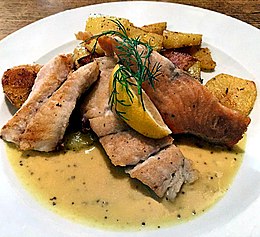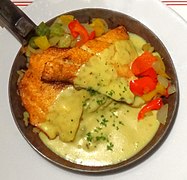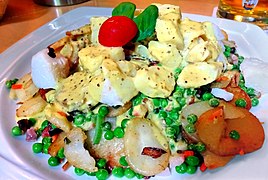Panfish
Pannfisch ( Low German Pannfis 'pan fish' ), also Hamburger Pannfisch or Hamburger Pfann (en) fish , is a traditional dish in Hamburg cuisine that is now considered “ typically North German ” and is widespread throughout northern Germany . The main ingredients are fried or cooked pieces of fish without a head, fried potatoes and mustard sauce . Formerly a "poor man's meal" and leftovers , the pan dish is now partly prepared with game fish and can also be found in upscale restaurants.
history
Pannfisch is one of the most traditional dishes in regional cuisine in Hamburg . Founded in the former abundance of fish in the Elbe and the nearby North Sea , it is characterized by a wide variety of fish dishes, which until well into the 20th century were mainly prepared with herring , cod and plaice (as well as eel ). Originally came Hamburger Pannfisch as an inexpensive yet nutritious food in poorer households in the lower layers, such as in Hamburg dockers , on the table. It was prepared as leftover food if there were fish or potatoes left over from the day before. In addition to leftover fish, remnants and sections of fresh fish (without a head) were also used, which were inexpensive in the port, fish trading and fish processing city of Hamburg. In historical recipes, the pieces of fish were cooked in broth , mixed with crispy fried potatoes in the frying pan and served with a thick mustard sauce bound with flour . Often times the sauce had to mask the taste of the fish scraps.
The dish has been handed down at least since the middle of the 19th century; For example, in her Hamburg cookbook, first published around 1890, Ada Rée described a refined form in which she used boned pieces of freshly cooked sea fish for her pan fish. The early spread of the dish in northern Germany can be demonstrated, among other things, by the Bremen cookbook , which was published in 1949 by the women's acquisition and training association in Bremen and contains a classic recipe for pan fish . Recipes for a related dish under the same name “Pannfisch”, but which was prepared with stockfish and mashed potatoes and is a variation of the southern stockfish dish brandade , were also found outside the northern German region early on. However, mustard does not appear at all in this stockfish dish, which has since gone out of fashion in Germany.
In addition to the historical recipes, Pannfisch is regularly described in various modern cookbooks - especially in collections of classics of (North) German regional cuisine and in fish cookbooks. Corresponding recipes can be found that are mostly based on the classic Hamburg method of preparation, for example in the large family cookbook (as "Recipe from the Waterkant ") by Martina Kittler at Gräfe und Unzer (GU), in the GU classic collection of German cuisine new discovered! by Matthias F. Mangold and in the standard work Germany - The cookbook by Alfons Schuhbeck . This refers to the Hamburg origin of the recipe and describes it according to the traditional method of preparation, although he does without the roux and instead binds the mustard sauce with cream and cold butter.
Today's method of preparation and the importance of the dish are characterized by the Hamburger Abendblatt as follows: “Today, what was once inexpensive food for port workers is prepared with fine pieces of fish fillet and the mustard sauce is usually served separately. The classic and at the same time cheap leftover food has now become a very well-known Hamburg specialty. "
Ingredients and preparation
fish
Today fish scraps are no longer used for pan fish, but “only the best, fresh goods” such as fish fillets without skin from cod, coalfish (“saithe”) and haddock . Part is Pannfisch, depending on the regional offer, with soil, stone and halibut , flounder and sole cooked, while the cheaper pollock as frozen food especially for lunch is encountered Offer Details etc..
While the fish pieces were once cooked in broth, today there are many variations for preparation: Partly gets the fish a crispy breading , partly it is rolled in flour in a pan fried or just steamed . The fish fillets are usually cut into bite-sized pieces, but sometimes left whole and served on the potatoes after preparation. Before frying or steaming, the fish is usually marinated on both sides with salt , pepper and lemon juice .
Potatoes

For the fried potatoes, waxy potatoes are usually used, which are cooked in the skin, then peeled and cut into not too thin, even slices. The sliced potatoes are fried with frying fat in a (separate) pan until golden brown. Depending on the recipe and taste, vegetable oil , lard , clarified butter or butter can be used as frying fat . Sometimes onions cut into strips and also diced bacon are added. It is seasoned with salt and pepper.
The fried potatoes are sometimes prepared from raw potatoes, for which waxy varieties are also best suited. The potatoes are peeled and cut into thin slices or cubes. So that they do not get mushy when frying, the sliced raw potatoes can be soaked for a few more minutes to remove the starch . They should definitely drain well before roasting.
mustard sauce

The flavor of the sauce is influenced not only by the use of different types of mustard, but also through the base: Classic is bound with flour sauce ( roux ), while today often sauces approach with white wine , rear and cream is refined. Fish stock is usually used, but vegetable stock or meat stock is often used , sometimes together. Usually finely chopped onion or shallot cubes are first sweated in butter, deglazed with white wine and boiled down, then stock or broth is added and boiled down to half and topped up with cream. As a mustard ingredient, many recipe authors recommend a spicy, sometimes grainy Dijon mustard , others use Pommery mustard, medium-hot table mustard or a mixture of different types of mustard. After adding the mustard, which should be done shortly before serving, the sauce is heated again and can be refined by adding chopped herbs such as chives , chervil and dill .
Other ingredients and side dishes
As a down-to-earth classic dish, pan fish gets by with the main ingredients mentioned and is usually served without any other side dishes. In some recipes and in some restaurants, vegetables such as peas and carrots , spinach leaves , peppers , stewed cucumbers or savoy cabbage are added; Sometimes pickles , lettuce or cucumber salad are also served with the dish .
In another variant, the mixed pieces of fish and fried potatoes are brought to a standstill with a few beaten eggs in the pan.
Serving
In classic recipes, the separately fried or cooked pieces of fish are added to the finished fried potatoes and mixed in the pan, then plenty of mustard sauce is added. Traditionally Pannfisch earlier was "served in a pan," while today - especially in restaurants - the court most often as an individual portion in deep plates or a serving pan done is. The mustard sauce is often served separately. As a garnish , lemon wedges or wedges and fresh herbs are mostly used.
"Hamburger Pannfisch" - here served in a serving pan in the Hotel Atlantic Kempinski in Hamburg
"Hamburger Pannfisch" - in a restaurant in Hamburg
“Bremer Pannfisch” - variation with vegetables in a restaurant in Bremen
"Helgoland Pannfisch" - variation with completely left fish fillets in a restaurant on Helgoland
“Flensburger Pannfisch” - variation with vegetables and bacon in a restaurant in Flensburg
"Ivendorfer Pannfisch" - variation with a kind of Greek salad at a restaurant in Ivendorf, a municipality of Travemuende
literature
- Tom Dieck: Pottkieker. 50 classic north German dishes with a history . Koehler, Hamburg 2013, ISBN 978-3-7822-1079-9 , pp. 28-29 .
Web links
- Heinz Wehmann : The Pannfisch always has to add its mustard on Abendblatt.de from June 3, 2010
- Hanseatic culinary art - information and recipe for Hamburger Pfannfisch on Koch-Welten.de
Individual evidence
- ↑ a b (lf): Formerly a leftover meal, today a delicacy. In: Abendblatt.de . June 1, 2010; accessed on March 5, 2018.
- ↑ a b c d e f Heinz Wehmann : The pan fish always has to add its mustard. In: Abendblatt.de . June 3, 2010; accessed on March 5, 2018.
- ^ Ada Rée: Hamburg cookbook. All recipes with exact measurements and weights. Josef Habbel, Berlin around 1890 ( excerpt from Koch-Welten.de ).
- ^ Women's acquisition and training association (ed.): Bremer Kochbuch. Schünemann, Bremen 1949, p. 77: Pannfisch (Reprint: Schünemann, Bremen 2010, ISBN 978-3-7961-1963-7 ).
- ^ Sophie Wilhelmine Scheibler : General German cookbook for all stands. C. F. Amelang, Berlin 1866, pp. 250–251: No. 741. Pannfisch (preparation with stockfish, see: Digitized in the Google book search).
- ↑ Henriette Davidis : Practical cookbook for ordinary and fine cuisine. 19th edition. Velhagen & Klasing, Leipzig a. a. 1874, p. 229: No. 66. Pannfisch (preparation with stockfish, see: Digitized in the Google book search).
- ↑ Martina Kittler: The great family cookbook. Gräfe and Unzer, Munich 2012, ISBN 978-3-8338-2261-2 , p. 157: Pannfisch ( digitized in the Google book search).
- ↑ Matthias F. Mangold : German cuisine rediscovered! Gräfe and Unzer, Munich 2015, ISBN 978-3-8338-4473-7 , p. 156: Pannfish with mustard sauce .
- ^ Alfons Schuhbeck : Germany - The cookbook. 2nd Edition. ZS Verlag, Munich 2017, ISBN 978-3-89883-697-5 , pp. 134–177: Fish & Seafood >> Pannfisch ( digitized in the Google book search).
- ↑ a b The classic of the kitchen: Hamburger Pannfisch . In: Bild.de . February 21, 2010; accessed on March 5, 2018.
- ↑ a b Marlies Fischer: Quite the best fried potatoes. In: Abendblatt.de . January 31, 2015; accessed on March 5, 2018.
- ↑ a b Hanseatic culinary art - recipe for Hamburger Pfannfisch . In: Koch-Welten.de ; accessed on March 5, 2018.







